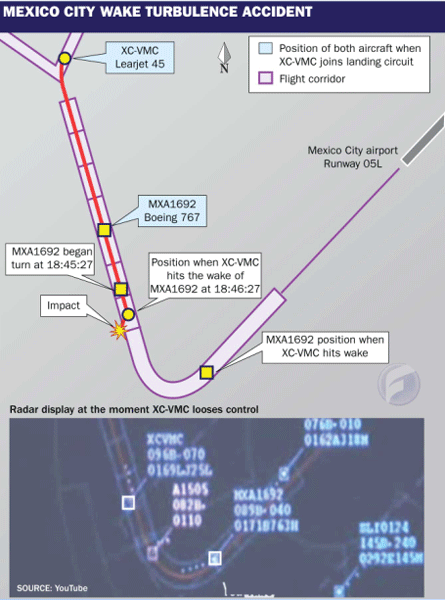Mexican investigators suspect that in-trail turbulence from a Mexicana Boeing 767-300 caused the loss of a Bombardier Learjet 45, after the executive jet closed to less than the minimum separation distance during the approach to Mexico City (see graphic). If the investigators' suspicions are borne out, this event is very similar to one in 1993 when an Israel Aircraft Industries Westwind business jet encountered a Boeing 757's wake on approach to John Wayne airport, California and crashed out of control.
On 15 December 1993 the Westwind was making a visual flight rules approach to runway 19R at John Wayne airport when a United Airlines 757, on a different frequency until it intercepted the localiser from a steep descending turn, was sequenced ahead of it. The Westwind crew were not given wake separation information, and although the captain elected to fly "one dot high" on the glideslope to try to ensure his aircraft was above the 757's wake, the 757's steep intercept meant the Westwind hit the turbulence. All five people on board the Westwind died
.

In the 4 November Mexico City approach, although the Learjet pilots were instructed to reduce speed to maintain separation, the aircraft continued to catch up with the 767. When it encountered turbulence, the Learjet failed to recover from the in-flight upset and crashed into a city street.
Images from a ground surveillance camera, released by the Mexican transport ministry, show the 767's white tail lights as it flies overhead and turns left onto its final approach to runway 05L. A minute later the camera briefly captures the Learjet diving steeply towards the ground and exploding on impact. Along with the three crew and six passengers - among them the Mexican interior minister - five people on the ground also died.
The transport ministry has released radar data showing how the Learjet, XC-VMC, was sequenced to land behind Mexicana flight MX1692, a 767-300 arriving from Buenos Aires, and ahead of a Click Mexicana Fokker 100 operating as QA7225. At the time the aircraft were sequenced the Learjet was 6nm (11km) behind the 767. Mexico City approach controllers instructed the Learjet - whose ground speed was much higher than the 767's - to reduce speed to 180kt (333km/h).
Radar data, says the ministry, shows that the Learjet did not begin to slow "significantly" until more than a minute later. While the required minimum separation between the 767 and the Learjet was 5nm, the two were only 4.15nm apart about 15s before the Learjet upset occurred. "We know that the crew acknowledged the presence of turbulence, says Mexican transport secretary Luis Tellez, " and...immediately after this recognition of wake turbulence the aircraft...began its descent...at a very pronounced angle, culminating in its impact with the ground". There is no evidence, he adds, of any technical malfunction.
Source: Flight International























